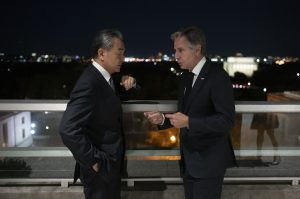The China-U.S. relationship is undergoing a “thaw,” to use U.S. President Joe Biden’s term. The consecutive visits of U.S. Secretary of State Antony Blinken, Treasury Secretary Janet Yellen, Special Envoy for Climate John Kerry, and Commerce Secretary Gina Raimondo to China over the last few months are clear indicators. The two countries are trying to stabilize the bilateral relationship before their presidents meet again next week. Facing this window, reducing misperception is key to avoid unrealistic expectations that might ruin the process.
The strategic communities in Washington and Beijing may have very different and rather questionable understandings regarding the reasons why the other side wants to stabilize the relationship.
One popular idea in Washington is the so-called “peak China” hypothesis. According to this view, China’s rise reached its zenith and the Chinese government is facing tremendous challenges, including a shrinking and aging population, slowing economic growth, social unrest, as well as a deteriorated international environment. Therefore, Beijing is forced to stabilize its relationship with the United States from a weak position.
It is hard to forecast whether China’s rise has peaked or not, since this is a long-term issue. Obviously, China has great potential to rise since its income on a per capita basis has only reached a level of $12,000 last year, and China’s domestic and international strategies in the future represent the key variables.
From Beijing’s perspective, even if China-U.S. relations are stabilized, it remains impossible for Washington to loosen its economic and technological restrictions and ease the geopolitical pressure on China. Therefore, a thaw will not solve the short-term challenges facing China. Chinese decisionmakers welcome a thaw based on the simple belief that stable bilateral relations serve China’s interest in the long run, and a “strategic showdown” needs to be avoided.
Interestingly, there is a contrasting version of the “peak China” hypothesis in Beijing, and that is the notion that “the East is rising and the West is declining.” This view argues that compared with the rise of China and emerging economies, the United States and probably the entire West are declining. The advocates of this viewpoint believe that after the “trade war” and “technology war,” the U.S. found it is impossible to stop that trend. As a presidential election year is coming, the Biden administration can only “correct the mistakes” and change its confrontational policies to China.
Similar to “peak China,” it’s too early, if not completely wrong, to say whether the West is declining or not. Even if the gap in economic size between the U.S. and China continues to narrow, it is quite clear that the position of the U.S. as the world’s most powerful country will still be maintained for quite a long time. Washington’s policy adjustments are not made from a feeling of weakness. To the contrary, the Biden administration probably believes that its strategic competition with China has been quite successful in the past three years, and if the current trajectory continues, the U.S. would win its long game with China. Based on this assessment, if the U.S. and China were pulled into a conflict or war, both countries would confront a lose-lose situation. Therefore, stabilizing China-U.S. relations is in the best interest of the United States too.
The judgment that the other side’s policy adjustment results from weakness represents a big misperception. If the U.S. and China cannot accurately understand the other side’s motives for seeking a thaw, they may have unrealistic expectations about the other side’s actions. When they find out that those actions cannot meet their expectations later on, they may become more disappointed and disillusioned.
The thaw could be buried and confrontations could be reinstated, as we have experienced last February. Both countries were angered by the “balloon incident” and then we squandered three months in this thaw process, which was initiated by the two presidents at the G-20 summit last November. Now the window is open again. Let’s keep our mind sober and fingers crossed.
In a series of articles, Chinese and American experts intend to make explicit the misperceptions that drive the mistrust in the ever-increasing instability in the bilateral relationship. Find the whole series here.

































